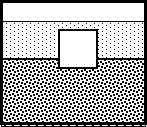
Workshop module 11 - Physics 113, Fall 2000
Fluids and start of simple harmonic motion
1. A rubber hose is attached to a funnel, and the free end is bent around to point upward. Water is poured in the funnel until it is partially filled. The fluid reaches static equilibrium. Is the pressure greater toward the left or the right of point A? How does the level of the water in the funnel compare to that in the hose? Why?

2. How do hot-air balloons work?
3. A cubical block of wood floats at an oil-water interface in a large tank. The block is 9.0 cm on a side and has its lower surface 1.5 cm below the interface. The density of the oil is 750 kg/m3. What are the forces on the block? Draw a free body diagram for the block. What is the mass of the block?

4. A tornado passes by your house. When the first windows break, does the glass blow inside the house or outside the house. Why?
5. A pipe enters a house in the basement carrying water with a speed of 3 ft/s at a pressure of 25 lbs/in.2. The pipe has an inside diameter of 1.0 in. as it enters the house. What is the speed and pressure of the water coming out of a faucet on the second floor of the house, assuming the pipe has tapered to an inside diameter of 0.5 in. and that the faucet is 30 ft above the point the pipe enters the house? (hint: There are two unknowns here. You will need two equations. Is the amount of water flowing out of the pipe on the second floor the same as the amount of water flowing into the house? Is energy conserved?)
6. A buoy of uniform cross section A and mass M floats in sea water of density r .